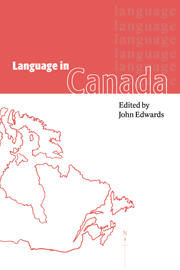Book contents
- Frontmatter
- Contents
- List of figures
- List of maps
- List of tables
- Notes on contributors
- 1 Canada
- Introduction
- 1 The foundations
- 2 The fading Canadian duality
- 3 Official bilingualism: from the 1960s to the 1990s
- 4 Official multiculturalism
- 5 Language in education: bridging educational policy and social psychological research
- 6 Aboriginal languages: history
- 7 Aboriginal languages: current status
- 8 French: Canadian varieties
- 9 French in Quebec
- 10 French in New Brunswick
- 11 French outside New Brunswick and Quebec
- 12 English: Canadian varieties
- 13 English Quebec
- 14 The teaching of international languages
- 15 French immersion in Canada
- 16 Language in Newfoundland
- 17 Language in Prince Edward Island
- 18 Language in Nova Scotia
- 19 Language in New Brunswick
- 20 Language in Quebec: aboriginal and heritage varieties
- 21 Language in Ontario
- 22 Language in Manitoba
- 23 Language in Saskatchewan: Anglo-hegemony maintained
- 24 Language in Alberta: unilingualism in practice
- 25 Language in British Columbia
- 26 Language in the Northwest Territories and the Yukon Territory
- Index of names
- Index of language families, languages, dialects
- Index of subjects
8 - French: Canadian varieties
Published online by Cambridge University Press: 18 February 2010
- Frontmatter
- Contents
- List of figures
- List of maps
- List of tables
- Notes on contributors
- 1 Canada
- Introduction
- 1 The foundations
- 2 The fading Canadian duality
- 3 Official bilingualism: from the 1960s to the 1990s
- 4 Official multiculturalism
- 5 Language in education: bridging educational policy and social psychological research
- 6 Aboriginal languages: history
- 7 Aboriginal languages: current status
- 8 French: Canadian varieties
- 9 French in Quebec
- 10 French in New Brunswick
- 11 French outside New Brunswick and Quebec
- 12 English: Canadian varieties
- 13 English Quebec
- 14 The teaching of international languages
- 15 French immersion in Canada
- 16 Language in Newfoundland
- 17 Language in Prince Edward Island
- 18 Language in Nova Scotia
- 19 Language in New Brunswick
- 20 Language in Quebec: aboriginal and heritage varieties
- 21 Language in Ontario
- 22 Language in Manitoba
- 23 Language in Saskatchewan: Anglo-hegemony maintained
- 24 Language in Alberta: unilingualism in practice
- 25 Language in British Columbia
- 26 Language in the Northwest Territories and the Yukon Territory
- Index of names
- Index of language families, languages, dialects
- Index of subjects
Summary
INTRODUCTION
The first French-speaking colony in North America was established by Champlain in 1604 at Port-Royal (present-day Annapolis Royal, Nova Scotia) on the Bay of Fundy, which came to be called ‘l'Acadie’ (Acadia). Four years later, Champlain founded a colony at Quebec, on the St Lawrence River, which was to become the centre of New France. These two establishments were to have separate and independent development and were to give rise to the two principal French dialect areas in Canada: Acadian French (AF) and Quebec French (QF). From the very beginning, AF and QF were relatively distinct since the great majority of the early settlers in Acadia came from the Poitou, Aunis and Saintonge area of western France and were mainly agricultural workers; the Laurentian colonists (Trois-Rivières was founded in 1634 and Montreal in 1642) came from a great number of areas of central, western and northern France, but particularly from Normandy (some 19 per cent), Île-de-France (18 per cent) as well as from Poitou-Aunis (22 per cent); settlers from the latter did not arrive until after 1640 (Charbonneau and Guillemette, 1994).
In this brief chapter, my purpose is not to review the history of the French-speaking populations of Canada but rather to describe some of the linguistic features that characterize Canadian French (CF) varieties.
- Type
- Chapter
- Information
- Language in Canada , pp. 160 - 176Publisher: Cambridge University PressPrint publication year: 1998
- 6
- Cited by

